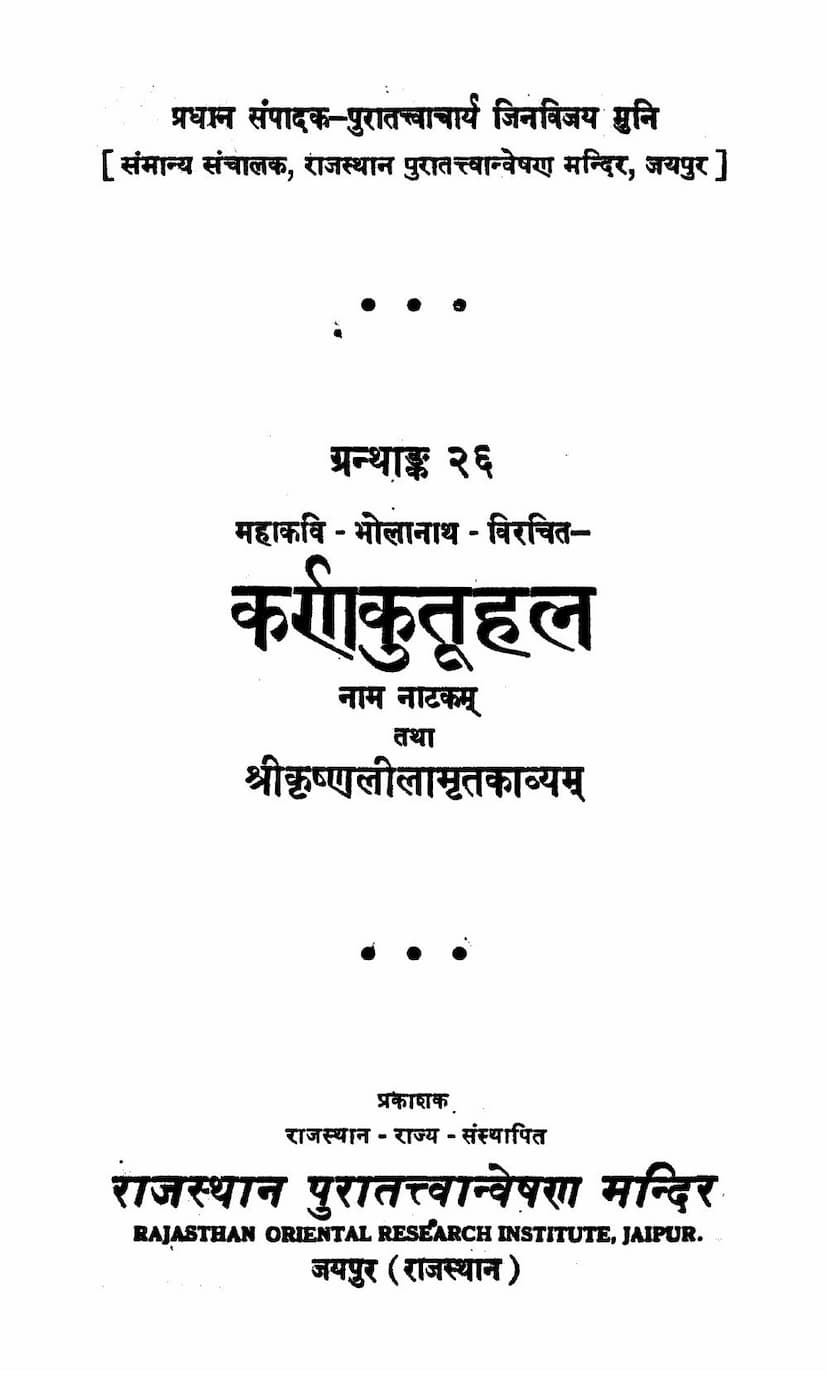Karn Kutuhal
Added to library: September 2, 2025

Summary
This comprehensive summary is based on the provided Jain text, focusing on the "Karn Kutuhal" and "Shri Krishna Leelamrit Kavya" by Mahakavi Bholanath Jain, published by Rajasthan Puratatvanveshan Mandir.
Book Title: Karn Kutuhal Author: Mahakavi Bholanath Jain Publisher: Rajasthan Puratatvanveshan Mandir Catalog Link: https://jainqq.org/explore/010595/1
Overall Context:
The book is published as part of the "Rajasthan Prachin Granthamala" (Rajasthan Ancient Texts Series), a project by the Rajasthan Oriental Research Institute, Jaipur. This series aims to discover, collect, preserve, edit, and publish rare and ancient literary works from Rajasthan, written in Sanskrit, Prakrit, Apabhramsha, Rajasthani, and Hindi. The preface by Principal Editor Muni Jinavijaya emphasizes the importance of these lesser-known works for understanding ancient Indian history and culture.
"Karn Kutuhal" (A Play):
- Author: Mahakavi Bholanath Jain, a poet from Kanyakubja Brahmin lineage. He was a talented poet in both Sanskrit and Hindi, whose works were largely unknown until this publication.
- Subject Matter: "Karn Kutuhal" is described as a short play (Natakam). Although it begins in a traditional dramatic style, it evolves into a narrative (Akhyayika), thus not strictly adhering to all the rules of drama.
- Inspiration and Patronage: The play was composed in honor of Maharaja Shri Sadashiv, the guru and chief advisor to Maharaja Pratap Singh of Jaipur. The editor, Gopal Narayan Bahura, deduces that this Sadashiv Bhatt was an Oudumbar Bhatt, connected to the royal lineage, and likely the same Sadashiv Bhatt mentioned by Shyam Latt in 'Madhavsinh Aryashatak' and as the proponent of 'Achara Smriti Chandrika'.
- Historical Context: The play is set in the context of the rulers of Matsya Desh (modern Rajasthan). It specifically mentions Maharaja Madhavsinh (I) and his grandson Maharaja Pratap Singh, highlighting the latter's appreciation for scholars and artists.
- Plot Summary:
- First Utuhal (Act/Section): The play begins with the Sutradhar (stage manager) inviting the Nati (actress) to stage a new play in honor of Bhatt Sadashiv. The narrative then shifts to the kingdom of Matsya Desh, introducing Maharaja Madhavsinh, his father Jay Singh, and his grandson Pratap Singh. The Nati then performs a song and dance, and the audience praises her beauty.
- Second Utuhal: The Maharaja summons the queen. They engage in drinking and intimate conversation, depicting the theme of 'Sanyog Shringar' (union in love).
- Third Utuhal: The queen's friend recounts a story to the Maharaja. This story is about Prince Ahavakirti of Karnpur. Dissatisfied with his royal life, he travels and arrives at Dharmapur. He befriends King Punyakirti. Due to his wife's incompetence, Ahavakirti lives separately, receiving a gold coin daily. A series of events, including a robbery and a mix-up with a wealthy merchant's daughter (Gunavati), leads to Ahavakirti marrying Gunavati. Gunavati, through her intelligence and virtue, manages their household and wins Ahavakirti's heart. Later, a supernatural event involving a Shiva yogini reveals that the king's life is in danger, and only the sacrifice of Ahavakirti's newborn son can save him. Gunavati, demonstrating extreme devotion, prepares to sacrifice her child. The Shiva yogini intervenes, revealing her intervention was a test of Gunavati's devotion. The king, witnessing these events, is amazed and decides to give his daughter in marriage to Ahavakirti, along with a substantial dowry. Ahavakirti returns to his father with both his wives.
- Literary Merit: The play is praised for its descriptions of nature, love, and the beauty of the characters. The language is described as simple Sanskrit, befitting a Rajasthani poet. The plot is noted to be similar to other popular legends, but Bholanath Jain has added his own creative touch.
- Mahakavi Bholanath's Biography: The introduction provides a detailed account of Mahakavi Bholanath's life and lineage. He was from Devakulipur, learned in Sanskrit and Hindi, and was honored with the title of 'Mahakavi' by Maharaja Pratap Singh. He had connections with various royal courts, including Bharatpur and Jaipur. His works include poems, songs, and translations in Brajbhasha, Punjabi, and Sanskrit.
"Shri Krishna Leelamrit Kavya" (Poem on Krishna's Divine Play):
- Author: Also by Mahakavi Bholanath Jain.
- Subject Matter: This Sanskrit poem is based on the Tenth Canto of the Shrimad Bhagavata Purana and describes the divine plays of Lord Krishna.
- Connection to Jaipur: The poem is believed to be connected to the Shri Govardhannathji temple in Hawa Mahal, Jaipur, established by Maharaja Pratap Singh in Samvat 1847.
- Literary Style: The poem is praised for its sweet and devotional description of Krishna's life and activities.
Overall Significance of the Publication:
The publication of these two works under the Rajasthan Prachin Granthamala is significant because it brings to light the literary contributions of a previously obscure poet. It also highlights the cultural patronage of the rulers of Rajasthan, particularly the Jaipur rulers, and their appreciation for arts and literature. The effort to preserve and publish such ancient texts is crucial for understanding the rich cultural heritage of India.